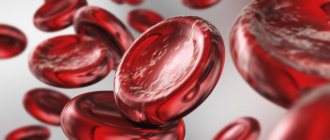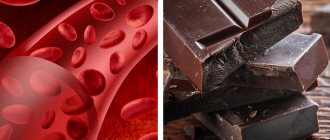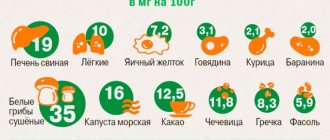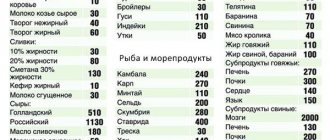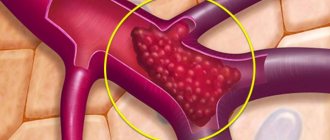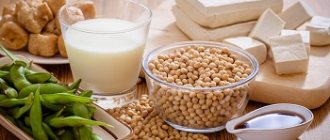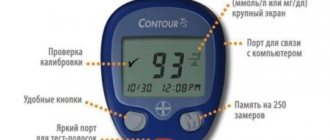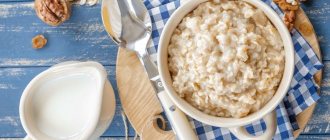A dangerous disease of the endocrine system, diabetes mellitus, does not manifest itself as spontaneously as the flu or food poisoning. A person is inclined to explain the primary signs of poor health by fatigue, poor nutrition “on the go,” and age-related changes in the body. Often, prediabetes and type 2 diabetes are diagnosed in the stage of progressive development only during a routine medical examination or medical examination.
If glucose levels are unstable, the patient is prescribed therapeutic nutrition. To control the disease, you need to know which foods lower blood sugar and which cause hyperglycemia and subsequent complications. The diagnosis of diabetes mellitus involves changes in lifestyle, eating behavior and permanent monitoring of blood sugar levels.
The importance of proper nutrition in diabetes
If you have diabetes of any type and stage of development, you need to monitor your diet every day. A properly selected diet not only prevents the disease from progressing, but also helps to cope with it. For example, in the early stages it is enough to adjust your diet and adhere to the established rules. Then you can be completely cured even without medications.
Diet therapy involves creating a balanced diet based on the optimal amount of essential nutrients (proteins, carbohydrates, fats) and total calories.
In this case, special indicators are also taken into account, for example, bread unit (XE). This is the name for a measure that reflects the total amount of carbohydrates in a particular food product. The mass of bread taken as 20-25 g per unit (in terms of pure carbohydrates is 10-12 g, i.e. half as much).
A person suffering from diabetes should consume a maximum of 25 bread units every day, i.e. no more than 250 g net carbohydrates. The permissible value is often less - it all depends on the type, stage of development of the disease, weight, age, general condition and the presence of physical activity.
Thus, to ensure proper nutrition it is necessary:
- Make a diet according to your doctor's recommendations.
- Develop a food menu for the week.
- Select products by quantity based on calorie content, nutritional value and bread units.
- Follow these rules strictly for a significant period of time.
- Include regular physical activity, which will also help reduce glucose levels.
When it matters
For type 1 diabetes
Insulin-dependent diabetics inject a certain dosage of insulin for each carbohydrate consumed (expressed in bread units) so that it safely transports sugar into the cells and prevents its increase in the blood. However, they have restrictions on the daily intake of XE. The less of them a product contains, the more varied, healthy and balanced the diet will be.
Example. For breakfast, an insulin-dependent diabetic needs to take no more than 5 XE. You can prepare dumplings with cottage cheese (only 100 g for 3.17 XE) and drink a cup of coffee with milk (a little more than 1.5 XE). Another breakfast option for the same 5 XE: 150 g of oatmeal with milk for 2 XE, add berries and nuts to it (not even 0.5 XE), 20 g of whole grain bread with Russian cheese (1 XE) and the same cup of coffee with milk for 1.5 HE.
The second option is more varied, more satisfying, and most importantly, healthier for a diabetic. Yes, in the first case, it will not violate the norm of bread units, but at the same time: it will not receive vitamins, and the dumpling dough is a fairly fast carbohydrate. This means that it will provoke a small but sharp increase in blood sugar. Of course, insulin administered half an hour before breakfast will transport it into the cells and prevent hyperglycemia, but after an hour you will want to eat again. The cottage cheese and milk left to be digested in the stomach will not last long.
Slow carbohydrates and protein foods contain a small amount of bread units (per 100 g - less than 1 XE), allowing you to eat a varied and balanced diet. Therefore, knowing how to operate with this information, patients can stabilize their blood counts so that there are no surges in GLU. All you need to do is have the appropriate table in front of your eyes.
For type 2 diabetes
Insulin-dependent diabetics follow a stricter diet than non-insulin-dependent diabetics. If they can afford the breakfast given in the example above, then only if a number of conditions are met: low-fat cottage cheese, soy flour for making dumplings, oatmeal with water, and it is better to replace it with barley or barley porridge, berries only sour. Why is that?
In type 2 diabetes, the body produces too little insulin or the tissues cannot absorb sugar. Therefore, the patient’s task is to include in the diet something that does not contain carbohydrates at all (pure proteins) or so that they are as slow as possible. The rate of glucose release into the blood is reflected by the glycemic index. Ideally, the menu of a non-insulin-dependent diabetic should contain only those foods with a GI of less than 35 units. Occasionally you can enjoy those in which it is in the range of 40-50, but no more (see full tables of GI products here.
With adequate treatment and choosing the right foods, patients can significantly improve their quality of life. These two components ensure stable blood biochemistry, thereby determining the calm course of the disease, without attacks.
For hypoglycemia
At certain points, foods that lower blood sugar can seriously harm your health. If a person has a tendency to hypoglycemia, he should not limit his diet exclusively to protein foods. As soon as the glucose concentration drops, you must definitely eat something that will increase it to the normal level (a piece of sugar, sweet juice, candy). Low-carbohydrate diets are strictly contraindicated for such people.
Blood sugar levels
When losing weight
The diet of someone losing weight should be dominated by foods that lower blood sugar levels, because this indicator affects the processes of formation and breakdown of fat cells.
If it is normal, insulin is produced in moderate quantities and successfully copes with its function: transporting glucose from the blood into cells, where it is converted into useful energy.
If sugar is elevated and insulin is produced in large quantities, it still does not have time to transport glucose into the cells in a timely manner, since there is too much of it. And he has no choice but to send all the excess to the formation of reserves in the form of fat deposits.
Therefore, when losing weight, you need to focus on foods with a low GI, because they help lower blood sugar, stabilizing this indicator and preventing the formation of extra pounds:
- low GI ≤ 35 units (foods that reduce blood sugar and promote weight loss);
- average GI = 40-50 units (helping to stabilize sugar and weight, that is, keeping them at the same level);
- high GI ≥ 55 units (increasing sugar levels and contraindicated for weight loss, promoting weight gain).
Those who are losing weight can also use a nutrition system that calculates bread units, as with type 1 diabetes. However, there you need to significantly reduce the daily intake of XE (to 10-15 units) in order to get rid of extra pounds.
Examples of a balanced breakfast, lunch and dinner
Menu planning is the main task for a diabetic. We must assume that the maximum calorie content is 1800-2000 kcal per day. Based on this, the composition and quantity of products for each meal are selected.
Breakfast
For tomorrow you can prepare dishes from the following products:
- rye bread (50 g) and butter (5-7 g);
- boiled chicken egg;
- milk glass (200 ml);
- porridge from any cereal (100 g).
Instead of porridge, you can include one of the following dishes:
cottage cheese with a moderate fat content of 4-5% (100 g);
- apple;
- plum;
- peach;
- apricot;
- any citrus (except lemon, lime).
The fruit should be of medium size - the weight in terms of pure pulp is about 100 g. Moreover, it is better to leave the fruit for an afternoon snack as a separate meal. Instead, you can use half a glass of milk (100 ml) for a snack.
Dinner
Lunch is the main meal, so it should be complete. For example, for a proper lunch you can consider the following dishes:
- fish soup or chicken soup (you can use broth with lean meat) 150 ml;
- boiled meat 100 g;
- boiled potatoes 100 g;
- black bread 50 g;
- raw or boiled vegetables 200 g;
- fruit (from those listed above) 100 g.
Dinner
A complete dinner can be prepared using the following products:
- boiled potatoes 100 g;
- any fish (low-fat) 100 g;
- fruits or vegetables 100 g;
- black bread 30 g.
Finally, as a late dinner (1-1.5 hours before bedtime), you can use a glass of low-fat kefir.
Lifestyle change
In addition to adjusting the grocery list, it is important to change your daily routine. Glucose levels will be reduced by quitting smoking and excessive alcohol consumption - habits that are dangerous to the pancreas. It is important to drink at least 1.5-2 liters of water per day, including herbal infusions, green tea, linden decoction, in order to more effectively remove sugary compounds from the body.
It is advisable to “break” the entire daily amount of food into portions and eat little by little, but more often. Optimally, five times a day, including two small snacks. Proper sleep and control of emotional health reduce stress, and therefore glucose levels.
Add sports to your life. The more a person moves, the more efficiently the body uses glucose. You can choose one of the types of load recommended by doctors:
- swimming;
- yoga, Pilates, gentle exercises like tai chi;
- cycling or roller skating;
- slow jogging;
- hiking, Swedish walking (with special poles).
Foods prohibited for diabetes
If you have diabetes, you need to exclude or significantly limit a number of foods. These include:
- sugar, honey and sweets;
- sweet soda;
- smoked meats;
- fat meat;
- baking;
- margarine;
- fermented milk products (if they are fatty).
If you can’t give up sweets, you can use fruits and vegetables, as well as sugar substitutes, such as xylitol. Moreover, the quantities of these products should also be limited - it is better to consult a doctor first.
Special cases
For men
Men who are overweight or have diabetes usually find it easy to lower their sugar levels. As soon as they see a list of products that have this property, they unquestioningly agree to such a diet: meat, fish, seafood. However, representatives of the stronger sex need to know that all this should be minimally fatty. If meat, then chicken breast or turkey fillet without fatty layers, if fish, then tuna or blue whiting.
In diabetes mellitus, consumption of fatty foods leads to the formation of atherosclerotic plaques in the blood, which complicates the course of the disease. If you are overweight, this will result in a set of new kilograms.
All men should know one more nuance. In many alcoholic drinks, GI and XE are equal to zero. Yes, they not only simply reduce the concentration of glucose in the blood, they provoke its sharp drop. This is fraught not only with fainting, but also with coma. Therefore, despite this property of alcohol, it turns out to be harmful to both the diabetic and those losing weight.
For women
Women, if they do not suffer from chronic hypoglycemia, need to constantly focus on foods that reduce sugar, as they:
- prolong youth;
- improve the condition of hair, skin and nails;
- maintain normal weight, maintain a beautiful figure;
- allow you to avoid problems with conceiving and bearing a child;
- ease the course of menopause.
If gestational diabetes was diagnosed during pregnancy, most sugar-lowering drugs are prohibited so as not to harm the intrauterine development of the child. The only effective treatment is diet therapy focused on low GI foods. The same goes for expectant mothers who have gained too much weight.
For children
Children cannot live without sweets, and they increase, not decrease, sugar. If the child develops normally, a moderate amount of them will only be beneficial (to improve mental abilities). If he suffers from diabetes or obesity, he will have to follow a diet taking into account the glycemic index or bread units.
Can I drink coffee?
The question of drinking coffee for diabetes has not yet received a clear answer. There is an assumption that caffeine improves the sensitivity of body cells to the hormone insulin. Based on this, coffee can not only be drunk if you have diabetes, but it is also necessary. In addition, the drink improves your mood, makes you feel more alert, and stimulates brain activity.
On the other hand, there is also harm:
- increased blood pressure;
- load on the heart muscle;
- powerful diuretic effect (can be quite useful);
- weakening of bone tissue;
- increased acidity levels;
- insomnia.
Thus, diabetic patients can be advised to drink one cup of weak coffee every day. At the same time, you should not put not only sugar in it, but also cream. Cinnamon would be a useful addition as it also helps lower sugar levels.
Gender characteristics
For men
In men, glucose usually decreases after exercise. This happens especially often if you run to the gym immediately after work, forgetting to eat. Therefore, before classes, you must definitely drink the same protein-carbohydrate cocktail. If you look at the glycemic index of sports nutrition, it is quite high. This means that these products will increase sugar and ensure the effectiveness of the workout.
In second place among the reasons is alcohol abuse and, as a result, dehydration of the body. Therefore, the next day, when you have a hangover, you definitely need to eat foods that raise your sugar levels quite significantly.
For women
Hypoglycemia is usually diagnosed in women after 50, during menopause. Therefore, they feel overwhelmed and tired. This is due to hormonal changes in the body. Foods that increase glucose levels can normalize your well-being.
A sharp decrease in glucose is often observed in pregnant women. The same hormones are to blame, as are the expectant mothers themselves, who need to do everything: go to maternity school, buy a stroller, and cook dinner for their husband. If hypoglycemia is diagnosed in women during pregnancy, they are prescribed a special diet, and attacks are stopped with the same sweets (refined sugar or candies).
Why don't my sugar levels go down?
If the diet is balanced and takes into account prohibited foods, total calories and nutrient content, sugar levels can at least be maintained within acceptable limits. But sometimes even proper nutrition doesn’t really help. This is due to various reasons:
- no or very little physical activity;
- severe, ongoing emotional stress;
- violation of the dosage of administered insulin;
- consequences of a stroke or heart attack.
It is quite possible to control and even reduce blood glucose levels with proper nutrition. But it is important to understand that this is not the only way, so with diabetes you need to adjust your entire lifestyle, not just your diet. In addition, the patient should monitor glucose fluctuations and periodically consult a doctor for advice.
Scroll
Common list
You can reduce sugar with the following products:
- vegetables;
- unsweetened fruits;
- sour berries;
- greens;
- nuts, seeds (poppy, sunflower, pumpkin, flax, sesame);
- mushrooms;
- some cereals (pearl barley, barley, sprouted wheat);
- cheese, dairy products;
- fish, seafood;
- meat, meat products and offal;
- sauces, spices, seasonings, herbs;
- tea, coffee, some alcoholic drinks;
- juices (tomato, lemon, currant, grapefruit, tangerine).
TOP 10 best
The fastest and most effective ways to lower sugar are:
- Jerusalem artichoke
- Cinnamon.
- Broccoli.
- Chicory.
- Spinach.
- Asparagus.
- Citrus.
- Wheat sprouts.
- Sour berries: cranberries, gooseberries, currants, viburnum.
- Tea (black, green) without sweeteners.
Important note. If you have diseases related to sugar levels, you should definitely consult an endocrinologist when creating a menu and choosing products. When losing weight, consult a nutritionist.
What is forbidden to eat
Foods that raise blood sugar are contraindicated:
- sweets, including honey, sugar, jam, certain fruits and berries, sweet pastries and confectionery;
- smoked meats, marinades, spicy, salty dishes;
- lard, lamb fat;
- carbonated drinks;
- alcohol;
- chocolate;
- fast food.
When the patient is aware of which foods reduce blood sugar, it is much easier for him to create his menu. There are also foods that must be strictly limited.
The following list of allowed ingredients in moderate quantities will not cause harm:
- boiled, baked potatoes;
- pasta;
- bread made from premium flour;
- rice and wheat cereals;
- some fruits and berries;
- some special sweets with fructose.
Vegetables, cheeses, with a low glycemic index, normalizing blood sugar should be present along with other permitted foods in the patient’s daily menu.
Forbidden
White rice
Often, those who adhere to a healthy lifestyle and healthy diet replace potato and pasta side dishes with rice. Regular white milled rice. Unfortunately, this is not the best solution, since polished rice contains very few nutrients, but the GI is 89-90. It is better to choose basmati rice or brown unpolished rice, their index is only 50, which corresponds to the yellow group of products.
Long - for pilaf, round - for cabbage rolls. Cooking rice dishes Read more
